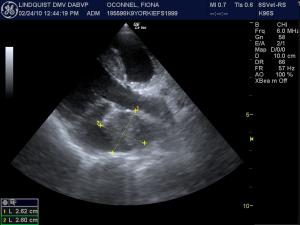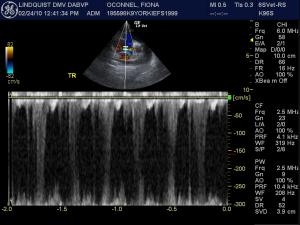Clinical Differential Diagnosis
Cardiologist Assessment: Dr. Peter Modler, Dipl.-Tzt. Dr.med.vet., FTA für Kleintiere (Small Animal Specialist, Austria)
A mass adjacent to the aortic body, most likely an aortic body tumor.
Left ventricular eccentric hypertrophy due to volume overload.
Left atrial dilatation.
Mitral insufficiency due to mitral prolapse and degenerative changes.
Tricuspidal insufficiency, Tricuspid dysplasia.
Right ventricular hypertrophy
Tricuspid regurgitation with a pressure gradient ~104 mm Hg
Mitral regurgitation with a pressure gradient of ~96 mm Hg
Combining these findings the following pathologies:
Sampling
Aortic body tumor
High-grade mitral insufficiency
Tricuspid valve dysplasia with moderate insufficiency
Severe Pulmonary hypertension
On the basis of our findings I would initiate triple therapy (Furosemide, Pimobendan, ACEI). I would probably add L-arginine (0,5-2g twice, depending on the size of the dog; L-arginine is a NO-precursor, there are no studies available on it´s use in veterinary medicine but it experimentally lowers pulmonary pressure and is – in human medicine – sometimes combined to other agents such as bosentane) and perhaps sildenafil (Viagra).
Prognosis is guarded. It is questionable whether elective pericardectomy should be performed for the aortic body tumor. The median survival time following pericardectomy is 730 days, without pericardectomy it is 42 days.






Comments